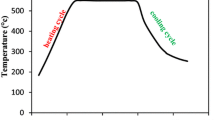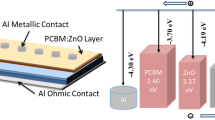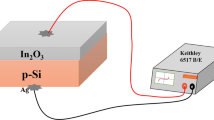Abstract
Metal-semiconductor (MS) heterojunctions are one of the main components of today’s technology. In the production of metal-semiconductor heterojunctions; metal oxides, insulators or polymers are inserted as interlayers between metal and semiconductor to ameliorate the durability, stability and efficiency of heterojunctions. By improving their durability, stability and efficiency through the use of ITIC as an interlayer material, the performance of these devices can be enhanced. By adding ITIC to the ZnO interlayer, ITIC: ZnO layer heterojunctions applications were carried out in this study. ITIC, a nonfullerene material, is employed as an electron acceptor material in organic solar cells. The ITIC:ZnO composite layer in our study was grown on Si substrates using spin coating method. Subsequently, Al/ZnO/p-Si and Al/ITIC:ZnO/p-Si heterojunctions were produced by physical vapor deposition method and the electrical properties of the produced devices were characterized. In these characterizations, current-voltage measurements were performed in the dark and under various light power illumination intensities ranging from 20 to 100 mW/cm2. From the current-voltage characteristics, various electrical parameters were calculated. While the ideality factor values for Al/ZnO/p-Si were found to be 7.55 and 7.73, it was found as 6.83 and 6.65 for ITIC-doped photodiode using thermionic emission and Cheung models, respectively. The barrier height values for Al/ZnO/p-Si were 0.62 eV, 0.64 eV and 0.64 eV, while the same values were found as 0.60 eV, 0.63 eV and 0.61 eV for Al/ITIC:ZnO/p-Si using the thermionic emission, Cheung and Norde models, respectively. From current transient measurements, photosensitivity, specific detectivity and responsivity were calculated as optoelectronic parameters. Moreover, the heterojunctions demonstrated high external quantum efficiency with the addition of ITIC. According to the results, ITIC component is functional for photodiode and photodetector applications.










Similar content being viewed by others
Data availability
The datasets generated during and or analyzed during the current study are available from the corresponding authors on reasonable request.
References
R.L. Hoffman, B.J. Norris, J.F. Wager, ZnO-based transparent thin-film transistors. Appl. Phys. Lett. 82(5), 733–735 (2003)
T.S. Natarajan, 16 - Functional nanofibers in microelectronics applications, in Functional Nanofibers and their Applications, Q. Wei, Editor. 2012, Woodhead Publishing. p. 371–410
N.A. Al-Ahmadi, Metal oxide semiconductor-based Schottky diodes: a review of recent advances. Mater. Res. Express. 7(3), 032001 (2020)
M. Gökçen et al., Frequency and voltage dependence of negative capacitance in Au/SiO2/n-GaAs structures. Mater. Sci. Semiconduct. Process. 15(1), 41–46 (2012)
A. Karabulut, I. Orak, A. Turut, Electrical characteristics of Au/Ti/HfO2/n-GaAs metal-insulator-semiconductor structures with high-k interfacial layer. Int. J. Chem. Technol. 2(2), 116–122 (2018)
R.K. Gupta, F. Yakuphanoglu, Analysis of device parameters of Al/In2O3/p-Si Schottky diode. Microelectron. Eng. 105, 13–17 (2013)
S.B.K. Aydin et al., ALD TiO2 thin film as dielectric for Al/p-Si Schottky diode. Bull. Mater. Sci. 37(7), 1563–1568 (2014)
B. Barış, Analysis of device parameters for Au/tin oxide/n-Si(100) metal–oxide–semiconductor (MOS) diodes. Phys. B: Condens. Matter. 438, 65–69 (2014)
A. Tombak et al., The novel transparent sputtered p-type CuO thin films and Ag/p-CuO/n-Si Schottky diode applications. Results in Physics. 5, 314–321 (2015)
I. Taşçıoğlu et al., Effects of interface states and series resistance on electrical properties of Al/nanostructure CdO/p-GaAs diode. J. Alloys Compd. 541, 462–467 (2012)
H.-I. Chen et al., Hydrogen sensing performance of a Pd/HfO2/GaN metal-oxide-semiconductor (MOS) Schottky diode. Sens. Actuators B 262, 852–859 (2018)
C. Arun Paul et al., Exploration of organic additives-assisted vanadium pentoxide (V2O5) nanoparticles for Cu/n-V2O5/p-Si Schottky diode applications. J. Mater. Sci.: Mater. Electron. 30(24), 20989–20996 (2019)
S. Mahato, J. Puigdollers, Temperature dependent current-voltage characteristics of Au/n-Si Schottky barrier diodes and the effect of transition metal oxides as an interface layer. Phys. B: Condens. Matter. 530, 327–335 (2018)
A. Kocyigit, I. Orak, A. Turut, Temperature dependent dielectric properties of Au/ZnO/n-Si heterojuntion. Mater. Res. Express. 5(3), 035906 (2018)
J.-J. Wu, S.-C. Liu, Low-temperature growth of well-aligned ZnO nanorods by Chemical Vapor Deposition. Adv. Mater. 14(3), 215–218 (2002)
Ü. Özgür, D. Hofstetter, H. Morkoç, ZnO Devices and Applications: A Review of Current Status and Future Prospects Proceedings of the IEEE, 2010. 98(7): p. 1255–1268
T. Abu Ali et al., Piezoelectric properties of zinc oxide thin films grown by plasma-enhanced atomic layer deposition. Physica Status Solidi 217(21), 2000319 (2020)
M. Yıldırım, A. Kocyigit, Characterization of Al/In:ZnO/p-Si photodiodes for various in doped level to ZnO interfacial layers. J. Alloys Compd. 768, 1064–1075 (2018)
E. Çokduygulular et al., A comprehensive study on Cu-doped ZnO (CZO) interlayered MOS structure. J. Mater. Sci.: Mater. Electron. 31(16), 13646–13656 (2020)
C. Bairam et al., Structural, morphological, optical and electrical properties of the Ti doped-ZnO (TZO) thin film prepared by RF sputter technique. Phys. B: Condens. Matter. 616, 413126 (2021)
R. Padma et al., Influence of nanostructure Fe-doped ZnO interlayer on the electrical properties of Au/n-type InP Schottky structure. Mater. Chem. Phys. 177, 92–98 (2016)
B.C. Şakar et al., Ultraviolet and visible photo-response of transparent conductive Al-doped ZnO (AZO)/n-Silicon isotype heterojunction device. J. Phys. D 55(42), 425107 (2022)
E. Karagoz et al., Flexible metal/semiconductor/metal type photodetectors based on manganese doped ZnO nanorods. J. Alloys Compd. 959, 170474 (2023)
F.E. Al-Hazmi, F. Yakuphanoglu, Photoconducting and photovoltaic properties of ZnO:TiO2 composite/p-Silicon heterojunction photodiode Silicon 10(3), 781–787 (2018)
M.R. Maurya et al., Wide spectral photoresponse of template assisted out of plane grown ZnO/NiO composite nanowire photodetector. Nanotechnology. 31(2), 025705 (2020)
S. Noothongkaew, O. Thumthan, K.-S. An, UV-Photodetectors based on CuO/ZnO nanocomposites. Mater. Lett. 233, 318–323 (2018)
A.A. Hendi, Electrical and photoresponse properties of graphene oxide:ZnO/Si photodiodes. J. Alloys Compd. 647, 259–264 (2015)
H. Wang et al., Photoelectric characteristics of the p–n junction between ZnO nanorods and polyaniline nanowires and their application as a UV photodetector. Mater. Lett. 162, 83–86 (2016)
S.S. Mousavi, B. Sajad, M.H. Majlesara, Fast response ZnO/PVA nanocomposite-based photodiodes modified by graphene quantum dots. Mater. Design. 162, 249–255 (2019)
S. Demirezen et al., Synthesis, electrical and photo-sensing characteristics of the Al/(PCBM/NiO: ZnO)/p-Si nanocomposite structures. Sens. Actuators A: Phys. 317, 112449 (2021)
M.O. Erdal et al., The modification of the characteristics of ZnO nanofibers by TCNQ doping content. J. Mater. Sci.: Mater. Electron. 32(13), 17220–17229 (2021)
S. Rajamanickam et al., Comparison study on the influence of pure PFO and PFO-ZnO nanorods in PFO/n-Si photodiodes. J. Polym. Res. 30(5), 181 (2023)
T. Baumgartner, Insights on the Design and Electron-Acceptor properties of conjugated Organophosphorus materials. Acc. Chem. Res. 47(5), 1613–1622 (2014)
L.-L. Deng, S.-Y. Xie, F. Gao, Fullerene-based materials for photovoltaic applications: toward efficient, Hysteresis-Free, and stable Perovskite Solar cells. Adv. Electron. Mater. 4(10), 1700435 (2018)
H. Li et al., High-performance inverted PThTPTI:PC71BM solar cells. Nano Energy. 15, 125–134 (2015)
B.A. Collins et al., Absolute Measurement of Domain Composition and Nanoscale size distribution explains performance in PTB7:PC71BM solar cells. Adv. Energy Mater. 3(1), 65–74 (2013)
T. Ozturk et al., Composition engineering of operationally stable CsPbI2Br perovskite solar cells with a record efficiency over 17%. Nano Energy 87, 106157 (2021)
H.H. Gullu et al., Electrical properties of Al/PCBM:ZnO/p-Si heterojunction for photodiode application. J. Alloys Compd. 827, 154279 (2020)
T. Öztürk, Effect of various PCBM doping on the interfacial layer of Al/PCBM:ZnO/p-Si photodiodes. J. Mater. Sci.: Mater. Electron. 32(8), 10180–10193 (2021)
H. Tian et al., Enhancement of p-Type dye-sensitized solar cell performance by Supramolecular Assembly of Electron Donor and Acceptor. Sci. Rep. 4(1), 4282 (2014)
C. Yan et al., Non-fullerene acceptors for organic solar cells. Nat. Reviews Mater. 3(3), 18003 (2018)
Z. Hu et al., Semitransparent ternary nonfullerene polymer solar cells exhibiting 9.40% efficiency and 24.6% average visible transmittance. Nano Energy. 55, 424–432 (2019)
L. Gao et al., High-efficiency Nonfullerene Polymer Solar cells with medium bandgap polymer donor and narrow Bandgap Organic Semiconductor Acceptor. Adv. Mater. 28(37), 8288–8295 (2016)
W. Zhao et al., Fullerene-free polymer solar cells with over 11% efficiency and excellent Thermal Stability. Adv. Mater. 28(23), 4734–4739 (2016)
Y. Yang et al., Side-chain isomerization on an n-type Organic Semiconductor ITIC Acceptor makes 11.77% high efficiency polymer solar cells. J. Am. Chem. Soc. 138(45), 15011–15018 (2016)
Y. Zheng et al., A highly efficient polymer non-fullerene organic solar cell enhanced by introducing a small molecule as a crystallizing-agent. Mater. Today. 21(1), 79–87 (2018)
G. Zhou et al., Photophysics, morphology and device performances correlation on non-fullerene acceptor based binary and ternary solar cells. J. Energy Chem. 47, 180–187 (2020)
J. Kim et al., A regioregular donor–acceptor copolymer allowing a high gain–bandwidth product to be obtained in photomultiplication-type organic photodiodes. Mater. Horiz. 8(1), 276–283 (2021)
H.R. Sim et al., Design and synthesis of a New Non-fullerene Acceptor for High-Performance Photomultiplication-Type Organic photodiodes. Adv. Opt. Mater. 9(4), 2001836 (2021)
Z. Zhong et al., Effects of charge injection barrier on the dark current of organic photodiodes. Org. Electron. 109, 106621 (2022)
M.O. Erdal, A. Kocyigit, M. Yıldırım, Temperature dependent current-voltage characteristics of Al/TiO2/n-Si and Al/Cu:TiO2/n-Si devices. Mater. Sci. Semiconduct. Process. 103, 104620 (2019)
R.T. Tung, Recent advances in Schottky barrier concepts. Mater. Sci. Engineering: R: Rep. 35(1), 1–138 (2001)
I.R. Kaufmann et al., A study about Schottky Barrier Height and Ideality factor in Thin Film transistors with Metal/Zinc Oxide nanoparticles structures Aiming Flexible Electronics Application. Nanomaterials. 11(5), 1188 (2021)
M. Soylu et al., Photoelectrical characterization of a new generation diode having GaFeO3 interlayer. Sol. Energy Mater. Sol. Cells 124, 180–185 (2014)
A.G. Al-Sehemi et al., Photodiode performance and infrared light sensing capabilities of quaternary Cu2ZnSnS4 chalcogenide. Surf. Interfaces 29, 101802 (2022)
S.O. Tan et al., Electrical characterizations of Au/ZnO/n-GaAs Schottky diodes under distinct illumination intensities. J. Mater. Sci.: Mater. Electron. 27(8), 8340–8347 (2016)
S.K. Cheung, N.W. Cheung, Extraction of Schottky diode parameters from forward current-voltage characteristics. Appl. Phys. Lett. 49(2), 85–87 (1986)
H. Norde, A modified forward I-V plot for Schottky diodes with high series resistance. J. Appl. Phys. 50(7), 5052–5053 (1979)
A. Kocyigit et al., The performance of chitosan layer in Au/n-Si sandwich structures as a barrier modifier. Polym. Test. 89, 106546 (2020)
A. Mekki et al., New photodiodes based graphene-organic semiconductor hybrid materials. Synth. Met. 213, 47–56 (2016)
S. Xing et al., Photomultiplication-type Organic Photodetectors for Near-Infrared sensing with High and Bias-Independent Specific Detectivity. Adv. Sci. 9(7), 2105113 (2022)
S. Demirezen, S. Altındal Yerişkin, A detailed comparative study on electrical and photovoltaic characteristics of Al/p-Si photodiodes with coumarin-doped PVA interfacial layer: the effect of doping concentration. Polym. Bull. 77(1), 49–71 (2020)
W. Jang et al., Superior noise suppression, response time, and device Stability of Non-fullerene System over Fullerene Counterpart in Organic Photodiode. Adv. Funct. Mater. 30(45), 2001402 (2020)
G. Forti et al., Recent advances in non-fullerene acceptors of the IDIC/ITIC families for bulk-heterojunction Organic Solar cells. Int. J. Mol. Sci. 21(21), 8085 (2020)
Z. Zeng et al., Carbon Nitride with electron storage property: enhanced exciton dissociation for high-efficient photocatalysis. Appl. Catal. B 236, 99–106 (2018)
W. Ananda, External quantum efficiency measurement of solar cell. in 2017 15th International Conference on Quality in Research (QiR): International Symposium on Electrical and Computer Engineering. 2017
R.D. Jansen-van Vuuren et al., Organic photodiodes: the future of full color detection and image sensing. Adv. Mater. 28(24), 4766–4802 (2016)
W.J. Yang et al., Internal quantum efficiency for solar cells. Sol. Energy. 82(2), 106–110 (2008)
Acknowledgements
The authors would like to express their gratitude to Selçuk University Scientific Research Projects Coordinatorship (Grant Number 17401159 and 21401073) and TÜBİTAK (The Scientific and Technological Research Council of Türkiye) for supporting under project number 122Z293.
Funding
This work was supported by Selçuk University Scientific Research Projects Coordinatorship (Grant Number 17401159 and 21401073) and TÜBİTAK The Scientific and Technological Research Council of Türkiye (Grant Number: 122Z293).
Author information
Authors and Affiliations
Contributions
TÖ: Conceptualization, methodology, writing original draft, experimentation. AAH: Experimentation, Investigation, writing original draft. MOE: Methodology, data curation. FD: Visualization, formal analysis. MY: Conceptualization, writing original draft, supervision. All authors have read and approved the final version of the manuscript.
Corresponding authors
Ethics declarations
Conflict of interest
The authors declare that there is no conflict of interest to disclose.
Additional information
Publisher’s note
Springer Nature remains neutral with regard to jurisdictional claims in published maps and institutional affiliations.
Rights and permissions
Springer Nature or its licensor (e.g. a society or other partner) holds exclusive rights to this article under a publishing agreement with the author(s) or other rightsholder(s); author self-archiving of the accepted manuscript version of this article is solely governed by the terms of such publishing agreement and applicable law.
About this article
Cite this article
Öztürk, T., Hussaini, A.A., Erdal, M.O. et al. Effect of an ITIC non-fullerene interlayer on electrical properties and external quantum efficiency of Al/ZnO/p-Si Schottky photodiodes. J Mater Sci: Mater Electron 34, 2020 (2023). https://doi.org/10.1007/s10854-023-11457-9
Received:
Accepted:
Published:
DOI: https://doi.org/10.1007/s10854-023-11457-9




